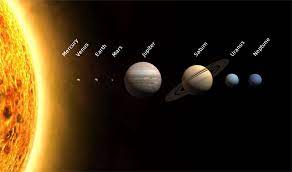Home
The milky way
Galaxys
Aliens
About me
Mercury
🇼🇦🇷🇳🇮🇳🇬❗link to meme included!
Press the back arrow to come back to the website frome the meme
Our Solar System
The planetary system we call home orbits a star in an outer spiral arm of the vast Milky Way galaxy(mmmm, Milky ways).
Why is it Called the Solar System? (i actually don't know)There are many planetary systems like ours in the universe, with planets orbiting a host star(they must be very 𝙃𝙤𝙩.hyuck hyuck). Our planetary system is called “the solar system” because we use the word “solar” to describe things related to our star(hense 𝚜𝚘𝚕𝚊𝚛 power), after the Latin word for Sun, "solis." Our planetary system is located in an outer spiral arm of the Milky Way galaxy.
Our solar system consists of our star, the Sun, and everything bound to it by gravity – the planets Mercury, Venus, Earth, Mars, Jupiter, Saturn, Uranus, and Neptune; dwarf planets such as Pluto; dozens of moons; and millions of asteroids, comets, and meteoroids. Beyond our own solar system, we have discovered thousands of planetary systems orbiting other stars in the Milky Way.
10 Need-to-Know Things About the Solar System
- ONE OF BILLIONS(make that trillions): Our solar system is made up of a star, eight planets, and countless smaller bodies such as dwarf planets, asteroids, and comets(stars with hair!).
- MEET ME IN THE ORION ARM: Our solar system orbits the center of the Milky Way galaxy at about 515,000 mph (828,000 kph). We’re in one of the galaxy’s four spiral arms.
- A LONG WAY ROUND:
It takes our solar system about 230 million years to complete one orbit around the galactic center.
- SPIRALING THROUGH SPACE:
There are three general kinds of galaxies: elliptical, spiral, and irregular. The Milky Way is a spiral galaxy.
- GOOD ATMOSPHERE(S):
Our solar system is a region of space. It has no atmosphere. But it contains many worlds – including Earth – with many kinds of atmospheres.
- MANY MOONS:
The planets of our solar system – and even some asteroids – hold more than 200 moons in their orbits.
- RING WORLDS(Wow! how many are married?):
The four giant planets – and at least one asteroid – have rings. None are as spectacular as Saturn’s gorgeous rings.
- LEAVING THE CRADLE(who's cradle?):
More than 300 robotic spacecraft have explored destinations beyond Earth's orbit, including 24 American astronauts who made the trip from the Earth to the Moon.
- LIFE AS WE KNOW IT:
Our solar system is the only one known to support life(says who?). So far, we only know of life on Earth, but we’re looking for more everywhere we can.
- FAR-RANGING ROBOTS:
NASA’s Voyager 1 and Voyager 2 are the only spacecraft to leave our solar system. Three other spacecraft – Pioneer 10, Pioneer 11, and New Horizons – will eventually hit interstellar space.
FAQ(what does FAQ mean anyway?): Which Spacecraft are Headed to Interstellar Space?
Five spacecraft have achieved enough velocity to eventually travel beyond the boundaries of our solar system. Two of them reached the unexplored space between the stars after several decades in space.
- Voyager 1 went interstellar in 2012 and Voyager 2 joined it in 2018. Both spacecraft are still in communication with Earth. Both spacecraft launched in 1977.
- NASA's New Horizons spacecraft is currently exploring an icy region beyond Neptune called the Kuiper Belt. It eventually will leave our solar system.
- Pioneer 10 and Pioneer 11 also will ultimately travel silently among the stars. The spacecraft used up their power supplies decades ago.

